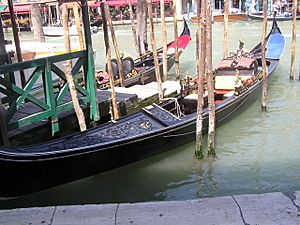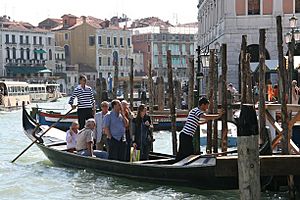Gondola facts for kids
A gondola is a traditional, flat-bottomed boat from Venice, Italy. It's perfect for moving around the city's many canals. A person called a gondolier stands and uses one long oar to move the boat. This oar also helps steer the boat. For hundreds of years, gondolas were the main way people traveled in Venice.
Today, these famous boats are still used for public transport. They act as traghetti (small ferries) to cross the Grand Canal. Gondolas are also part of special rowing races called regattas. But mostly, they carry tourists on rides through the beautiful city.
Contents
How Gondolas Work
A gondolier stands at the back of the gondola, facing forward. They row with a strong forward stroke. Then they do a backward stroke to keep the boat going straight. The oar rests in a special wooden holder called a forcola. This holder is shaped to let the oar move in many ways. It helps the gondolier steer, speed up, slow down, and even go backward.
Gondolas have a flat bottom. This means they can also drift sideways if needed. People sometimes think gondolas are pushed with a pole, like a punt. But the waters in Venice are too deep for that!
Gondola History and Design
Long ago, in the early 1900s, gondolas often had a small cabin called a "felze." This cabin protected passengers from bad weather or curious onlookers. It even had windows that could be closed with special shutters, like the first "venetian blinds." Later, these cabins were removed. Tourists wanted a better view!
In the past, gondolas came in many colors. But a special sumptuary law in Venice said they had to be painted black. So, today, almost all gondolas are black.
Hundreds of years ago, there were thousands of gondolas in Venice. Some people think there were up to ten thousand! Today, there are only about 400 active gondolas. Most of them are used for tourist rides.
The gondola you see today is different from older ones. Paintings from the past show gondolas with a lower front and a taller "ferro" (the metal decoration at the front). The curved, banana-shaped gondola we know was created in the 1800s. A boat builder named Tramontin designed it. The city government stopped any more changes to the design in the mid-1900s.
The oar, or rèmo, sits in the fórcola. This oar lock has a complex shape. It lets the gondolier use the oar in many positions. They can row slowly, powerfully, turn, slow down, and stop.
The metal decoration at the front of the boat is called the fèrro. It means "iron." It can be made of brass, stainless steel, or aluminum. The fèrro is not just for looks. It also helps balance the boat. It acts as a counterweight for the gondolier standing at the back.
Gondolas are built by hand. They use 8 different types of wood, like oak, cherry, and mahogany. Each gondola has about 280 pieces! The oars are made from beech wood. One side of the gondola (the left side) is made a little longer than the right side. This special design helps the boat go straight. It stops the gondola from turning left when the gondolier rows forward.
Symbols on the Gondola
Every part of the gondola has a special meaning. The iron prow-head, or "fero da prorà," is shaped like an "S." This "S" stands for the twists and turns of the Grand Canal.
Under the main blade of the fèrro, there's a comb-like part with six teeth. These six teeth represent the six "sestieri" (districts) of Venice. A tooth that sticks out backward symbolizes the island of Giudecca. The curved top of the fèrro looks like the Doge's cap. The Doge was the leader of Venice long ago. The semi-circular break between the curved top and the six teeth is said to represent the Rialto Bridge. Sometimes, you can see three small decorations between the teeth. These stand for the three main islands near Venice: Murano, Burano, and Torcello.
Gondolas are also used in special rowing races called regattas. Gondoliers use a unique rowing style called Voga alla Veneta.
The exact origin of the word "gondola" is still a bit of a mystery!
In 2010, a woman named Giorgia Boscolo became Venice's first female gondolier.
Gondolas in Culture
Many famous people and stories feature gondolas.
Mark Twain, a famous American writer, visited Venice in 1867. He wrote a lot about gondolas and gondoliers in his book The Innocents Abroad. He found them very interesting!
The first part of a funny opera called The Gondoliers by Gilbert and Sullivan is set in Venice. The main characters are gondoliers.
The Japanese comic book series Aria is about a young woman named Akari. She trains to be a gondolier in Neo-Venezia, a city on Mars that looks like Venice!
In an episode of The Scooby-Doo Show called 'A Menace in Venice', the gang visits Venice. They meet a ghost called the Ghostly Gondolier.
Images for kids
-
A gondola on the Providence River in Rhode Island, USA.
See also
 In Spanish: Góndola (bote) para niños
In Spanish: Góndola (bote) para niños















